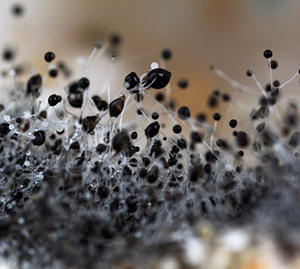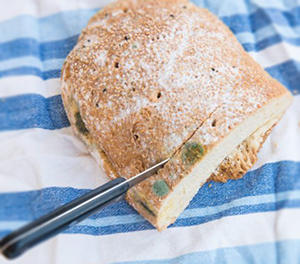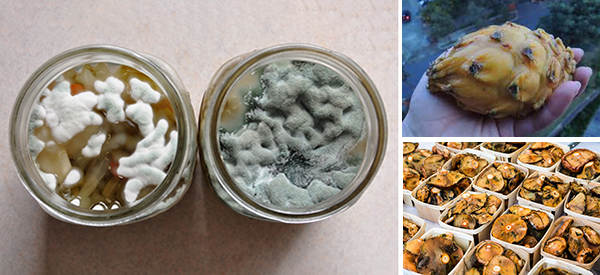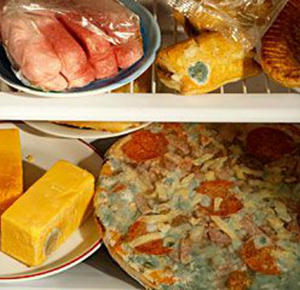I hate to think how much food I have wasted because of mold. My mother taught me well: “When in doubt, throw it out.” In many cases that is a good motto to live by. However, when it comes to moldy foods, it does not always apply. According to a report published by the USDA, many moldy foods are safe to eat, after removing the mold, of course.
Some people are very sensitive to molds. And molds can cause allergic reactions and respiratory issues, even in healthy people. Some molds produce mycotoxins that can make you very sick. However, others are beneficial, adding flavor to cheese and producing penicillin. So how can we know the difference? When is mold safe and when is it toxic?
What is Mold?
Mold is a type of fungi that reproduce by spores. The spores are transported by air, water, and insects and are difficult to kill. The spores spread the mold to new surfaces quickly or can remain dormant until a suitable growing surface appears.

Mold that grows only on the surface of foods seems like an easy problem to fix, simply cut the mold away and eat the remaining foods. However, this is not as safe as it seems. Molds grow in threadlike branches and roots that can spread and penetrate deep into the food. Imagine the veins of mold growing throughout a block of blue cheese. While the blue cheese molds are beneficial and visible, this is not true for most molds.
You cannot always see mold that has spread throughout a loaf of bread or other food. On the surface, the mold is colored by the spores it produces, but deep in the loaf the roots are microscopic in size and are not seen by the naked eye until they are found in high numbers.
Where Does Mold Grow?
Molds love warm, humid conditions, but they can grow anywhere that enough moisture is found, including in the refrigerator. They are found both indoors and outside.
Additionally, molds are more tolerant of salt and sugar than bacteria and other food contaminants. They can grow on refrigerated jams and jellies, salty meats, and even acidic foods like tomatoes and catsup.
Why are Molds Dangerous?
In addition to their role in respiratory illnesses and allergies, some molds produce poisonous substances called mycotoxins. Mycotoxins are found mostly in grains, nuts, and some vegetables. One of the most widespread mycotoxins produced is called aflatoxin. Aflatoxin is a mycotoxin produced by a specific mold growing on food crops, especially peanuts and field corn. Aflatoxin causes cancer and has been linked to other serious diseases in humans and animals.
Related: 7 Deadly Canning Mistakes Even Smart People Make
When to Throw Out Moldy Foods
Soft foods and moist foods that have even a tiny spec of mold are not safe to eat. Molds can easily grow roots down into and throughout soft foods and moist foods. Do not smell the food. Remember, molds can cause respiratory problems. Soft or moist foods that have become moldy should be thrown away, including:
- Bread
- Soft fruits and vegetables like strawberries, peaches, cucumbers, and tomatoes
- Leftover casseroles
- Meats, bacon, and processed meats like hotdogs and lunch meat
- Cooked rice, pasta, and other grains
- Condiments like catsup, jams, and jellies
- Yogurt, and sour cream
- Any soft or moist food that is moldy should be discarded.
- Soft cheeses that contain any mold other than the mold required to make them.
Foods that Can Be Trimmed and Eaten
Hard foods will only grow mold on the surface and can be eaten once the mold is removed. For these foods it is safe to trim away the mold and a wide margin of unaffected food. Do not let the knife touch the moldy part while trimming. The USDA recommends cutting away at least an inch of the food around and below the mold.
 For mold growing on the outside of hard salamis and dry cured country hams, you can safely wash the mold off the surface and use the meat.
For mold growing on the outside of hard salamis and dry cured country hams, you can safely wash the mold off the surface and use the meat.
You can safely trim and eat these foods:
- Hard cheeses
- Firm vegetables with low moisture levels such as carrots, cabbage, bell peppers
- Hard salami
- Dry-cured salamis sometimes have a thin, white coating of mold, which is safe to eat. They should have no other molds on them.
How to Prevent Mold from Growing on Your Foods
Keeping your kitchen and food storage areas clean and mold free is the best deterrent to mold. Molds are easily spread from one food to another, and mold spores can quickly build up in your refrigerator, bread box, and cleaning utensils.
When you discover moldy food, wrap the piece or the trimmings in plastic or place it in a small paper bag and discard it. Remove it from your kitchen as soon as possible to prevent more mold spores from being released.
Next, clean the area where it was stored to prevent spreading the mold. Additionally, clean the entire inside of the refrigerator monthly with one tablespoon of baking soda dissolved in a quart of water. Scrub visible mold off gaskets and crevices using a tablespoon of bleach in a quart of water. Rinse with clean water and dry the surface.
Keep your dishcloths, towels, sponges, and other cleaning items fresh and hang them to dry. A musty sponge or mop is spreading mold spores wherever you use it. Whenever possible, keep the humidity in the house below 40% to discourage mold growth.
Keep perishable foods covered to prevent exposure to mold spores. Cover foods with plastic wrap or keep them in storage containers. Refrigerate foods promptly and do no leave them out of the refrigerator for more than two hours.
Purchase foods in quantities that you are likely to use within a few days so that mold doesn’t have a chance to grow.
Play It Safe
If you follow the guidelines I have presented here, you will be safe. If you are not sure about a food, you could follow my mother’s advice, or you could remember what the FDA is telling us about how mold grows. On hard, dry foods, the mold cannot penetrate the food and trimming is all that is needed. However, moist foods or soft foods are easily invaded by the roots of the mold and can quickly be contaminated throughout the entire piece. Moist or soft foods should always be discarded. These rules will help you and your family avoid the dangers of moldy foods without wasting foods unnecessarily.
You may also like:
 14 Must-Have Canned Foods You Didn’t Know Existed
14 Must-Have Canned Foods You Didn’t Know Existed
10 Things Cowboys Carried With Them In The Wild West To Survive (Video)
How to Keep Eggs Fresh for a Year with Isinglass
7 Super Cheap Foods To Stockpile That People Usually Throw Away
















Just because one can, doesn’t mean one should. I could eat my boots, belt and probably my car seat, but I shouldn’t.
One should eat food if it’s still good to eat, instead of wasting it. And that’s in everyday life. What if the SHTF and, when you break out your stockpiled food, you find some of it has been affected by mold? Are you going to throw it out, or start assessing it to see if it’s still safe to eat or not? I know what I’ll be doing. Personally I grow and preserve most of my own food, and I’m not going to waste the effort that went into that if I can avoid it.
For me, the only item on that list of “safe” foods to eat if mold is present is cheese, but then cheese usually doesn’t stay around in this household long enough to grow mold. If vegetables have mold, they are composted. Usually by the time vegetables grow mold, they are wilted, soft and not fit to eat. Since I’m allergic to garlic, salami is out. It can grow all the mold it wants to. The best rule of thumb is what the author gave at the beginning – when in doubt, throw it out. That adage has always worked well and can be applied to nearly everything.
Anyone wishing to get rid of bacteria laden money, please wrap it properly in plastic, affix proper warning label to box/envelope, and forward to me. Please enclose $100 disposal fee. 😀
Rats! I wish I knew you earlier!
If you run into more than you can handle I have the proper equipment to help take care of your over-lode. And you can keep $50 of the disposal fee cause my equipment is paid for. And I use a smaller staff.
Money? What’s that?!!
As I read this article, I noticed a greenish-whitish powder spreading down from the top.
So, naturally, I deleted the first few paragraphs. Whew! Safe again! Thanks, Diane.
We have always scrapped off the mold from jellies and lived to tell about it.
Well aged meats always have mold on them before they are cut up… but are cooked…although some people like them rare.
These 2 examples lead me to question the accuracy of this article.
When I was a kid, my Dad talk about how the bacons would hang and get moldy. He said they scraped off the mold, cut off a chunk and brought it in. It was washed and trimmed, then sliced and fried. I vividly remember my Mother taking a spoon and removing any mold from the top of jelly. Nobody ever had food illness. We hardly ever had anything mold because back then you did not have a fridge full to over flowing. Mon bought groceries for 2 weeks and picked up bread and milk in between paydays. She canned and preserved. Dad hunted and fished to supplement the freezer/pantry/table. I apply these lessons from the past today.
Hello all, thank you for mold insights. I have often eaten avacados that have a little bit of mold or dark threads/areas. shall I stop this?
Paul, it’s like everything in life. You can walk down a dark street for ten years and never have anything bad happen. Then suddenly — boom! There are three thugs just waiting to stomp on somebody for no reason.
I’ve eaten moldy bread and moldy cheese by cutting off the moldy parts for as long as I have been an adult and I kind of think that my mother cut mold off of cheese and bread too. Never had any problem. According to this article I should have dropped over dead or at least gotten sick. Obviously I use a little judgement. If the entire slice of bread is grey/green, I toss it. If there is just a little mold on a couple of pieces, I cut it off and eat it. Same with cheese. If the block of cheese is covered with mold an inch thick, it gets tossed using rubber gloves. A single spot of mold on one side — down the hatch.
By the way, in case you are wondering how long I have been following this practice, I am over 80 and left to go in the Marine Corps just after I turned 18, so it has been a couple of years.
LLC, I’m 64, a young lad to you; I’ve eaten cheese that had mold on small spots; cut it off and enjoy what’s left. Bread, on the other hand, I toss even if I only see a small patch. Something in my head says, “get rid of it.” It’s always been that way with me, and my better half for these past 45 years.
And since we’re coming up on the 4th, have a happy one and THANK YOU for your service to this Country!
Thanks for your service, Chuck! Happy 4th to you and yours, and to everyone here.
Hello Left Coast Chuck, Thank You for your service! Our son is Marines also. I hear what you say, there is always a chance. I am pretty frugal and and do go over what everyone esle is throwing out. If it is super moldy or smells bad it goes into the ground to nurish edible plants. If it smells good i expect it probably is good.
If you want in-depth information on molds, mycology, their associated toxins and sinister effects go to http://www.knowthecause.com
Honestly, molds are not to be messed with and your contact with them should be minimized at every turn.
Sorry Geno, but that’s a massive oversimplification. SOME molds are not to be messed with. Plenty more are harmless or even beneficial. Like most things in life, what’s needed is a bit of common sense.
I just had to throw this out there. Remember the history lesson about the moldy rye. People started thinking there were witches and werewolves from the bad rye used to make bread. Upper crust didn’t get affected because they could afford to buy the expensive wheat and only the lower classes ate the moldy rye. Just an interesting note on mold.
That would be Ergot fungus. It contains lysergic acid. A compound that will make you hallucinate, also found in morning glories and Hawaiian wood rose seeds. This is the compound that is used to synthesize into LSD. Kind of the same effect on the hippies as the folks of Europe.
Yes. This also contributed to the Salem, MA witch trials. Apparently, everyone was eating ergot contaminated grain and subsequently were tripping out and thought it was a demonic attack. Exposure can also cause miscarriage. If you grow your own grain or harvest wild rice, be sure to check for signs of contamination. It usually grows on rye or wild rice and takes the form of the grains but is bigger and ranges in color from a pinkish color to a purple-black. It also smells strongly of rotten fish. It is used medically to induce labor, stimulate uterine contractions, and to treat migraines. If you see signs of contamination harvest elsewhere and destroy (by burning, I think.) or it will spread. Don’t inhale the smoke. Don’t try to eat it or feed it to livestock. It’s not a mold but a type of fungus.
The lost book of remedies seems to have several problems
I clicked on the physical + digital for $37. Order summary shows physical only for $37.
when paying it showed a cost of $49.23 and still did not show how to get digital copy or the 2 bonus books
Hi Ira, please check your email.
MK-20 (not certain of the number) is a green mold sprayed over salamis, peperoni and other meats to help preserve them. It’s considered harmless, but still gives me an alergic reaction when used. Yet, without it, these sausages and so on would have a shelflife of weeks, not months. Traditional made, they can be stored on a shelf at room temperature. A lot of soil molds are valuable for medicine and help plants to feed and thrive. And, of course, there’s Pennsylvania’s gross black shell mold, which will kill you. And the delightful witch powder, that grows in the gutrs of predators–AKA King tut’s Revenge/Valley Fever, it melts the lungs out.
I didn’t know this. We grew up pretty poor and we ate alot of stuff we shouldn’t have. To this day, I just dip mold off the jelly in the jelly jar and then keep/eat the rest of the jar of jelly (dipping off the mold on top each time I get the jar out to use). I have often thrown away the “moldy parts” of bread and ate the rest of the slice/loaf. If there’s a moldy berry (or a few moldy berries) in a bowl full, I just get rid of the moldy ones and eat the rest. We always just cut the mold off of ANY cheese, including Velveeta (I know it’s not “really” cheese!) and eat the rest. Never bothered to worry about the knife touching the mold – just used it to finish cutting the cheese after throwing away the moldy parts. Maybe I ought to quit eating all that stuff now that I’m not so poor anymore. It’s just a habit now, to not waste anything I don’t have to.
That’s a habit I grew up with, Appy. I learned it from my grandparents and it’s stayed with me my whole life. Don’t throw out anything unless you really have to. You won’t be able to waste anything in a crisis, so get into good habits now and save yourself some stress when your life depends on it.
If maple syrup gets moldy, just skim off the mold, put the syrup in a pan, bring it to a boil then put it in a clean glass jar and enjoy
interesting comments on mold. Everyone has an opinion or a saying they live by. Like the 3 second rule when you drop a piece of bread on the floor, or is it the 5 second rule?
5 seconds is what I’ve always heard, but for “dry” foods. If it’s something moist or sticky it should have the part that contacted the floor scraped off. “Dry” foods should be blown off to remove dust. ?
Sorry, folks but that whole 3 second, four second, five second…make it sixty second…doesn’t matter because those/it is ALL a pile of horsehockey hokum bee-ess old Wive’s tale! Say if you have a bit of living E. Coli on your kitchen floor from the residue from some sloppy sanitary accident, you drop anything on it, IT IS DONE, contaminated that instant…no waiting, and unless you can scrub that chunk of whatever food you dropped, under hot soapy water then disinfect it with alcohol, bleach, or iodine, or autoclave it or gas it with methyl bromide you are still left with an E. Coli culture that has simply been spread. And do you have any idea what pathogens we all carry on our shoes!?! Well, everything that is on the ground…the ground on a road, in an outhouse, in a bathroom, a restaurant floor. Would you care to lick a public bathroom floor?
5 second “rule” is (mostly) a kind of joke. You bring up valid points however, especially in light of a potential lack of sanitation especially in a shtf situation. You could also argue that in the here and now eating a salad made with romaine lettuce is likely to give you a roaring case of e coli induced poisoning. …washed properly or not so it seems.
HaHa, somebody mentioned Hawaiian wood rose seeds, we used to buy them in head shops (?) in the 70’s, never knew if you were going to get an incredible dose of LSD or a near fatal dose of strychnine.
Happy 4th of July, hands over hearts and hats off for the 80 year old Marine!
no food should be thrown out, eat what you can of it if its edible, if its not it can be fed to domestic animals-chickens, rabbits, pigs, alternatively it can be used as bait when fishing or trapping .
Here, here lonewolf. I have done this all my life and I will be 65 next week. I have rarely been sick, and read that when you give your body something like a bit of moldy food it engages the immune system into activity so you are helping build yourself up. I grew up poor in a family of 8 kids, so no way were we throwing out possibly edible food. I have carried over this practice to my current lifestyle, and on a fixed income it comes in handy.
Well for starters HAPPY BIRTHDAY next week I hit that number 10 months ago. You are right for the most part. For I feel your not dumb to the point of eating really moldy food. I use the taste and smell test myself, up to a point. I feel that any half ass intelligent person that doesn’t like to waste can easily figure out if it’s edible or not and if not sure. That is where you draw the line using the knowledge of your last 64 years it should be easy. And if not POINTED OUT HERE AS A JOKE Give some to the neighbors if they don’t get sick then eat it.
Great and pertinent discussion, that I would like to expand just a little. I have a habit of crockpot beans, plus, plus, plus. I eat from the pot daily, and what ever i have and may go with the taste goes into the pot, for a week or more. The pot stays hot, food tastes great. How long do you think the food is safe to eat and healthy in the crock pot? ThankYou!
Paul